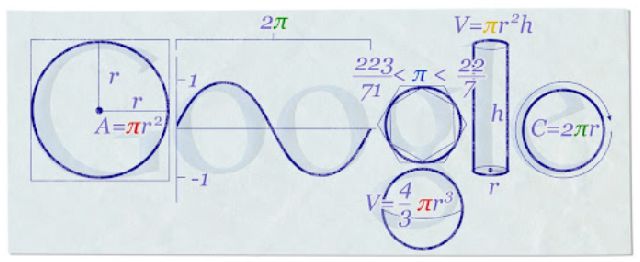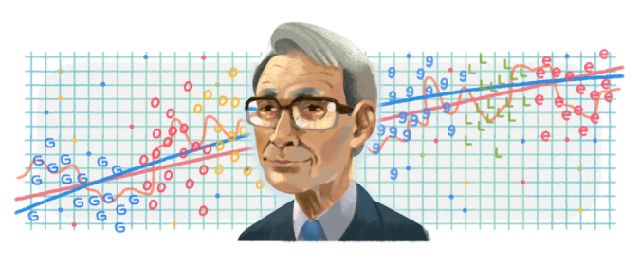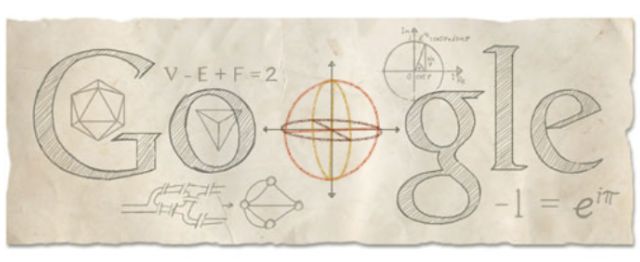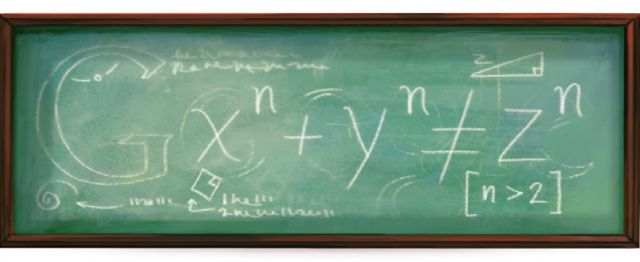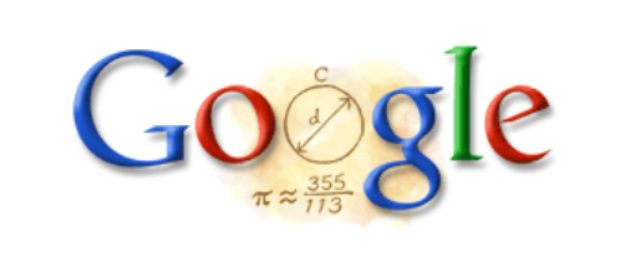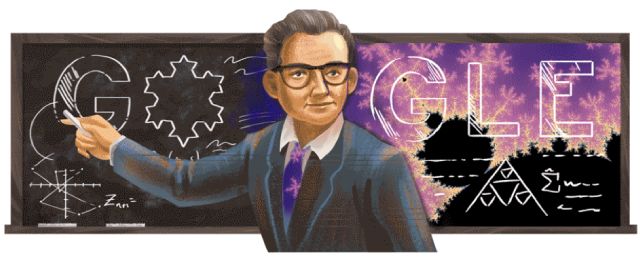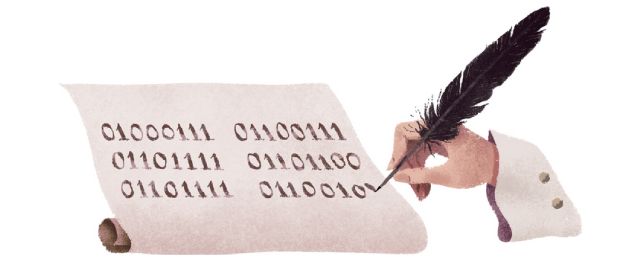The 10 best Math Google Doodles of all time
To celebrate Google's 25th birthday this September, we picked out our favourite Google Doodles about Maths. Do you agree? Share your favourite Maths Google Doodle with #BeAFirebrand
Drum-roll...
10. Pi Day
On March 14 every year (or, in US date format, 03/14), Google celebrates Pi Day.
The number pi (3.14) is the ratio of a circle's circumference to its diameter. This interesting number seems to be encoded in the patterns of life and has been calculated to more than a trillion digits beyond its decimal point.
Pi Day was founded on March 14, 1988 by physicist Larry Shaw of the San Francisco Exploratorium. Celebrations involve eating pie and competing in reciting the number.
9. Hirotugu Akaike’s 90th Birthday
"If you've ever conducted a statistical analysis, you might’ve spent hours thinking about which variables to include and the impact each would have on the outcome. But to ensure the model itself is accurate, shouldn’t someone measure the measures?"
Japanese scientist Hirotugu Akaike researched this issue for more than 20 years, presenting the answer as a simple equation, the Akaike Information Criterion. AIC allows analysts to select a model from a set of options by measuring how close the results are to the (hypothetical) truth and is the reason Google celebrated Dr Akaike with this Doodle.
8. Leonhard Euler's 306th Birthday
Here's a name you might remember from Math class: Leonhard Euler!
The 18th-century Swiss mathematician, physicist, astronomer, geographer, logician, and engineer is widely considered to be the most prolific mathematician, having written 866 publications during his lifetime, totaling 81 volumes of work. According to Carl Friedrich Gauss (number 2 in this list), "The study of Euler's works will remain the best school for the different fields of mathematics, and nothing else can replace it."
Euler is also famous for being the first to use the Greek letter pi (π) to denote 3.14 (see number 10), for solving the Basel problem, which had puzzled mathematicians for 150 years, and for defining another constant number, the base of the natural logarithm, which is known as e or Euler's number in his honour.
7. Pierre de Fermat's 410th Birthday
On 17 August 2011, Google celebrated the 410th birthday of Pierre de Fermat.
Fermat worked as a lawyer full-time and only practised math as a hobby; nevertheless, he is recognised for early developments that led to infinitesimal calculus, the discovery of an original method of finding the greatest and the smallest ordinates of curved lines, and research into number theory.
Perhaps his best-known work is the riddle, Fermat's Last Theorem, which has puzzled mathematicians for 400 years. The theorem states that no three positive integers a, b, and c can satisfy the equation an + bn = cn when n is greater than two. Fermat wrote he had discovered incontestable proof of this but never said what it was. The theorem remained unproved until 1995, when British mathematician Andrew Wiles successfully developed a solution.
6. Christian Doppler’s 214th Birthday
When a fire engine approaches, the siren gets louder as it comes closer, taxing your eardrums as it whizzes past, and then fades into the distance. Why does this happen?
The answer was proposed by mathematician and physicist Christian Doppler. Born in Salzburg, Austria in 1803, Doppler observed that the frequency of a wave depends on the relative speed of the source and the observer. Named the Doppler Effect, this phenomenon applies to both sound and light.
According to Google, "Simply put, sound is generated in ‘waves.’ As the source of such waves moves closer, the waves themselves take less time to reach you. They hit you with increasing frequency, making the sound more intense. As the source moves away, the waves start to spread out, and the sound becomes weaker.
"The Doppler effect also explains why stars in the sky appear to be of different colors. As a star approaches the earth, wavelengths compress and the star appears to be bluer in color. If the converse happens and a star is moving away from us, it appears redder."
5. Emmy Noether's 133rd Birthday
Albert Einstein once referred to Emmy Noether as “The most significant creative mathematical genius thus far produced” and the most important woman in the history of mathematics.
Emmy Noether was born in 1882. In her time, women were discouraged from pursuing STEM subjects to the extent that, when Noether was studying at the University of Erlangen, there was just one other female student. (Also, after finishing her degree, she had to teach without pay for seven years.)
Despite that, Noether made groundbreaking contributions which, according to Google, "changed the face of [abstract] algebra." She also discovered Noether's First and Second Theorems, which are fundamental in modern mathematical physics. Truly a name to be remembered!
4. Zu Chongzhi's Birthday
In 2009, Google celebrated the Chinese astronomer, mathematician, politician, inventor, and writer, Zu Chongzhi (Chinese: 祖沖之), born in the early 5th century AD.
Zu Chongzhi calculated pi as between 3.1415926 and 3.1415927, a record in accuracy which would not be surpassed for over 900 years. He also calculated the duration of a year as 365.24281481 days, which is very close to 365.24219878 days we know today, and distinguished the sidereal from the tropical year.
According to Google, as the Japanese mathematician Yoshio Mikami pointed out, "π was obtained several hundred years earlier by the Greek mathematician Archimedes, however milü π = 355/113 could not be found in any Greek, Indian or Arabian manuscripts, not until 1585 Dutch mathematician Adriaan Anthoniszoon obtained this fraction; the Chinese possessed this most extraordinary fraction over a whole millennium earlier than Europe.
"For this reason, Mikami strongly urged that the fraction 355/113 be named after Zu Chongzhi as Zu's fraction" or 'Zu's ratio.' This number is the best rational approximation to π and the closest rational approximation to π from all fractions with a denominator less than 16,600."
3. Benoit Mandelbrot's 96th birthday
On 20 November 2020, Google celebrated the 96th birthday of French and American mathematician, Benoit Mandelbrot, widely known as the “father of fractal geometry.”
Fractals are irregular yet infinitely repeating mathematical shapes found throughout nature and our everyday lives. Mandelbrot was inspired to research them in the 1950s, while working for the IBM Watson Research Center in New York. In 1975, he coined the now-famous term “fractal geometry” to describe these mathematical phenomena, forever altering the field of applied mathematics.
2. Johann Carl Friedrich Gauß’s 241st Birthday
At number 2, another familiar name from math class—Johann Carl Friedrich Gauß, also spelled Gauss, an 18th-century German mathematician, geodesist, and physicist.
Gauss was a child prodigy. At the age of three, he found an error in his father’s business payroll accounts; by the age of five, he was made responsible for overseeing them. At age seven, he shocked his teachers by almost instantly summing integers from 1 to 100, using a formula he created himself.
According to Google, "Gauß made substantial contributions to the fields of Algebra, Astronomy, and non-Euclidean geometries. He developed the Theorema Egregium, a method of calculating the curvature of a surface using angles and distances, as well as Gaußian statistics (the bell curve) and the Gauß Divergence Theorem. At the age of 24, he wrote “Disquisitiones Arithmeticae” which laid the foundation for modern number theory and is widely regarded as one of the most influential mathematics texts of all time."
1. Gottfried Wilhelm Leibniz's 372nd Birthday
Also called "The Last Universal Genius," Gottfried Wilhelm von Leibniz wrote works on philosophy, theology, ethics, politics, law, history, philology, games, music, and contributed to physics and technology.
The 17th-century German polymath earned a master’s degree in philosophy at 17 and a law degree at 20. One of his main achievements was developing the foundation of differential and integral calculus; unbeknownst to him, his contemporary, Sir Isaac Newton, was also working on this.
Leibniz also invented the binary system, which forms the basis of all computer programming, in 1679—and even the first mechanical calculator, called the “Step Reckoner,” which could perform addition, subtraction, multiplication, and division.
To celebrate Leibniz, his Google Doodle spells “Google” in binary.
Happy birthday, Google!
Explore Google with Firebrand
For the past twelve years in a row, we’ve been named one of the Top 20 IT Training Companies in the World. At Firebrand, we take Google certification very seriously, making it a core component of our accelerated courses, Apprenticeships, and Skills Bootcamps. Perhaps one of our accelerated Google courses is right for you? See them all.

